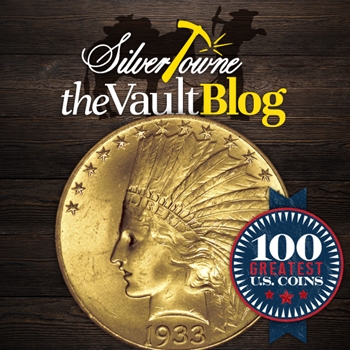
United States coinage has a rich history. United States gold coinage is a major contributor to that fact. Why? Beginning in 1795, gold coinage was produced on pretty much a continual and uninterrupted basis. That is, until the year 1933 when the suspension of all gold coinage took place.
In our next edition of our blog series focusing on Whitman Publication’s fourth edition of the top 100 Greatest United States coins, we look at a gold coin which is rare not because of its mintage, but because of how its story ended up. With author Jeff Garrett’s explanation and assistance by Ron Guth, we look deeper at why 1933 was such an important year for United States gold.
#41 - 1933 Indian Head Eagle
The banking system was in a crisis in 1933. American banks were more than unreliable as fear and panic stretched throughout the financial world. Closures were occurring which made account owners uneasy about the potential mishandling of funds and the disappearance of hard-earned money. The panic led to major withdrawals and the banking system just could not keep up with it. They were unable to provide the money customers had deposited.
This crisis led to Executive Order 6102 in which President Franklin D. Roosevelt made the ownership and monetary possession of gold illegal. This all happened after the Philadelphia Mint had already struck 312,500 examples of the 1933 Indian Head Eagle. Once the order came from the President, all gold coins were to be surrendered and melted back into bullion and added to the United States’ gold reserve. Almost every bit of the mintage of the 1933 Eagle was destroyed as the year itself became well-known for being the last year that gold coins were produced for almost 50 years.
It was recorded that the only gold coins minted that year were eagles and double eagles as they both came out of Philadelphia. It was thought that the 1933 Indian Head Eagle was the only gold coin legal to own. Now, as it has been made clear by the Treasury Department and the United States government, the one and only 1933 gold coin legal to own is the 1933 double eagle. Stay tuned for that story later on down the road as that coin is also on the top 100 list.
According to the publication, there are only an estimated 25-30 examples of this coin known today. While most are in Mint State condition, some are gem specimens and the only certified (MS66) example was sold at auction in 2004 for $700,000.
The historical value of the 1933 Indian Head Eagle in Choice Uncirculated condition in 1960 is listed at just $2,500. In 1980, that value increased to $75,000. Each edition of this publication has had an increase while the fourth edition and also the latest updated value places that same coin today at $450,000.







